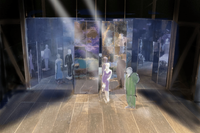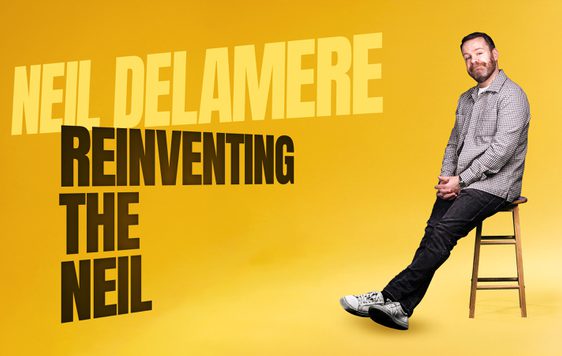News Story
‘Why did you choose such a small room for so many people?’ I hear you say! Wednesday was our first ‘big’ design meeting to start the ball rolling for Macbeth (an undoing). Obviously, things have been happening between the writer and other departments, but this was the first time the creative team were all in one place to talk specifically about design. For this meeting we would expect to see the writer, director, technical manager, stage team, production team, costume and of course the designers in the room. It becomes a fascinating merger of brains from creative to logistical, to piece the performance together.
Our Roseburn workshop was the setting for the initial sneak peeks for the set and costume for the production. There is a lot to consider when designing a set, from the space available to whether the show will go on tour. (Going on tour with a show means the designer must consider multiple performance spaces during the design process and think about how easy the set is to take apart and move to a new theatre.) They also think about whether any old set can be recycled and used in this new one as well as thinking about the design concept and initial conversations that have happened with Zinnie over cups of tea (okay coffee – making a show is hard work).
Normally, the designer will come to this meeting with a white card model box which is a tiny version of the stage with movable set and a card cut out of a person to see scale.


So, what is the purpose of a white card model?
To put it simply, it lets the creative team see what might be built, identify any initial problems or things that will need changing and then can talk creatively about design and how the concept fits with the overall feel of the production. The team also talk about lighting and how the set needs to work around any initial ideas that they have, for example, do they need the sides open so that side lighting can be used. The set designer also considers budget, what can realistically be achieved in the timescale given and the space available to them, whether the set changes throughout the play or if it is just one backdrop for the duration, how does the set change – is it moved by stage team or actors – they aren’t just considering if it looks good or not.
The costume department are also present in the room, they are there to talk about how their designs will work with the concept and to even identify any costumes that require extra space to come on and off stage (we’ve had this a few times). Did you know, costume also consider why the costume is worn on stage – Macbeth has A LOT of blood in it, so obviously we can’t wash the costume every night between shows so the department will have to make many versions of the same costume to make sure there is a clean one every performance! Can you imagine making 20 of the same dress, by hand, to the exact size of your actor...PHEW! The designer also thinks about how the set influences the costumes as well as casting and managing changes in ideas.
And sometimes...this meeting can result in the whole design and concept being changed.
- Set designers' ideas come from everywhere and anywhere. If you are interested in becoming a designer, here are our tips for finding your inspiration.
- Take photos of everything that interests you
- Mood boards are your best friend; they can help guide your ideas
- Explore different eras and how you would design them. What makes the 20s different from the 90s if you were to create a set/environment.
- Start with a practical prop, like a set of stairs and build around it.
- Create someone’s front room, based on people you observe in the world around you – this can be an interesting way to think about someone's own possessions and how they would fit into the world they are in.
- Consider how you would layer the space. Worlds aren’t flat 2D spaces, do you have steps or platforms, are there things hanging above your actors.
Designing for costume is the same approach but instead of a world you are looking at people and characters
Practice is key, the more you design and make the better you will become. Explore designing worlds that you imagine up, design for a play you have seen or one you have read. Work with designing for different spaces and stages. You don’t have to be employed as a designer to build a portfolio, grab some scissors, glue and pens and start designing.



